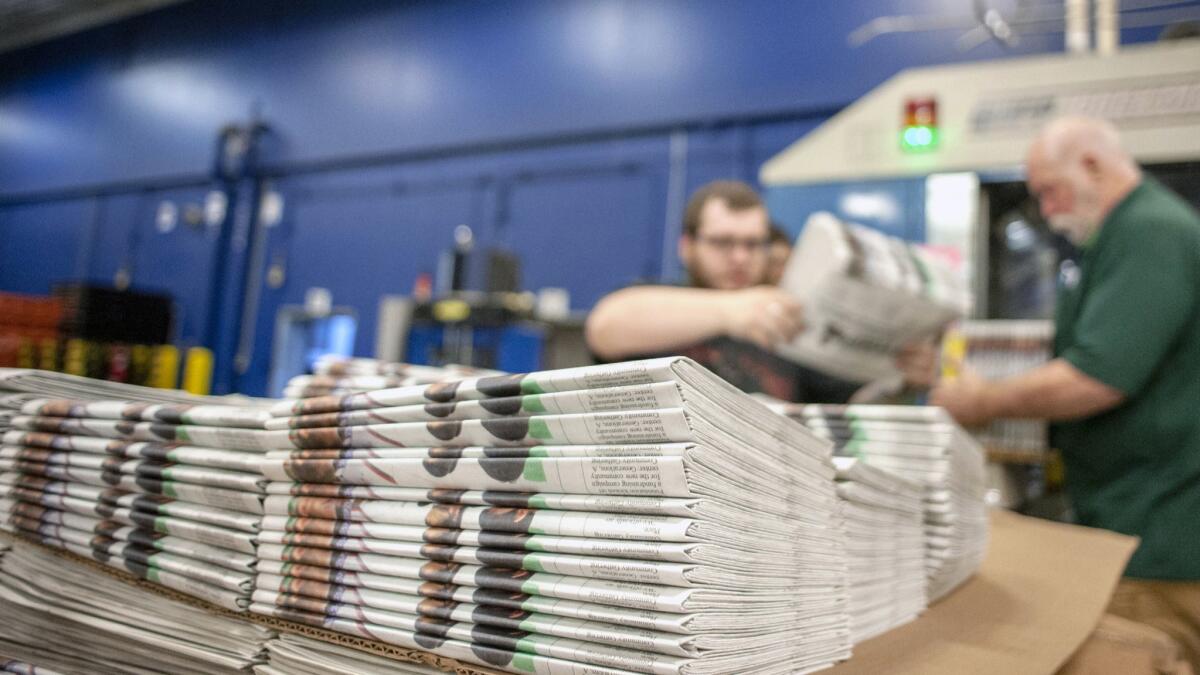International Trade Commission decision reverses Trump tariffs on newsprint

The U.S. International Trade Commission ruled Wednesday that imports of Canadian newsprint do not threaten or materially harm the U.S. newsprint industry, a decision that reverses tariffs put in place by the Trump administration this year.
The commission’s 5-0 ruling comes after the Commerce Department had put in place two sets of duties levied on producers and exporters of uncoated groundwood paper — the material on which most newspapers are printed — from Canada.
The first set of duties, levied in January, ranged from 4.42% to 9.93% of the wholesale price after a preliminary determination from the Commerce Department that suppliers had received financial assistance from the Canadian government. Two months later, another preliminary determination from the Commerce Department led to a separate round of anti-dumping duties of 22.16% for some Canadian paper producers and exporters.
After a final determination this month, the Commerce Department lowered the rates that producers and exporters of Canadian uncoated groundwood paper would pay. The anti-dumping duties were revised to 16.88% for one particular company and eliminated for all others, while the tariffs levied in January were decreased to a range of 0.82% to 9.81% of the wholesale price.
Newspaper groups have said the duties increased newsprint costs by nearly 30% for news organizations, which were already struggling with declining ad revenue. The Tampa Bay Times eliminated 50 jobs to cope with the estimated $3.5-million additional cost the paper expected to pay annually for newsprint as a result of the tariffs.
Paul Tash, chairman and chief executive of the Tampa Bay Times/Times Publishing Co., called the commission’s ruling “welcome news.”
“Newspaper publishing is still a tough business, but this is a good day,” he said. “We’ll see now that the tariffs are removed what happens to prices.”
However, he said it “seems unlikely” at this point that the newspaper would be able to bring back any of the jobs that were eliminated because of the tariffs, citing “pronounced” pressures in the retail business that have decreased advertising.
The Los Angeles Times was “pleased” with the ruling, “as it will help us continue to serve our print readers,” Los Angeles Times spokeswoman Hillary Manning said in a statement. During an earnings call in May, executives from The Times’ then-parent company, Tronc Inc., said they “strongly” opposed the tariffs, noting that newsprint was at “historically extraordinarily high prices” because of it.
Canadian paper mills provide about 60% of the 2.4-million-ton demand for newsprint in the U.S., according to an official from the News Media Alliance, a trade group that represents almost 2,000 news organizations. Twenty years ago, the U.S. was home to about 15 newsprint mills, but now there are only a handful left.
The Commerce Department has said imports of Canadian uncoated groundwood paper last year were valued at about $1.21 billion.
Both the International Trade Commission and the Commerce Department need to weigh in with affirmative rulings for any anti-dumping and counterveiling tariffs to go into effect. In January, the commission ruled that imported solar cells and modules did cause material harm to domestic manufacturers, leading to tariffs imposed by the Trump administration.
A Commerce Department spokesman said in a statement Wednesday that the commission’s decision shows that “the process, and its division of responsibilities is fair and transparent.”
“We have said from the beginning that ITC would determine if there is injury to U.S. companies — a key step in strict implementation of U.S. trade laws,” the statement said. “The Commerce Department’s role is to determine whether dumping or improper subsidies occurred and at what rate. We did that.”
A commission hearing on the issue in July lasted nine hours and included bipartisan testimony against the tariffs from more than a dozen congressional leaders, Tash said.
The commission will release a report with its opinion on the ruling to the Commerce Department in late September, and no statements on the reasoning will be released before then, a spokeswoman said.
The petitions that led to the tariffs were filed by a single paper mill: North Pacific Paper Co., a Longview, Wash., producer of uncoated groundwood paper that is owned by private equity firm One Rock Capital Partners.
The Wall Street Journal reported this month, citing government records, that a team from One Rock met with Commerce Secretary Wilbur Ross about the effect of Canadian newsprint imports on the firm’s investment in North Pacific Paper. Canadian firms’ low-cost access to trees cut on public land has also long been a complaint of U.S. lumber and paper companies, the Journal reported.
North Pacific Paper Chief Executive Craig Anneberg said in a statement that the company was “very disappointed” in the ruling and that it will assess its options after the commission’s written opinion is released.
In a statement this month after the Commerce Department’s final determination, North Pacific Paper said Canadian paper producers were “engaged in unfair trade practices, which harm American workers and cause material injury to our industry.”
The company said in a statement in May that it was to hire 50 new employees and restart one of its paper producing machines on a limited basis to meet the expected growth in demand created by the tariffs.
But the News Media Alliance, which cheered the commission’s ruling, said it has emphasized that the decline in demand for newsprint was due to a decades-long shift from print to digital platforms, “not imports from Canada.”
David Chavern, chief executive of the trade group, said in a statement that the group hopes the reversal of the tariffs “will restore stability to the market and that publishers will see a full and quick recovery.”
A price decrease could take at least a month or two to kick in, said Frank Romano, professor emeritus at Rochester Institute of Technology, who consults with newspapers and other publishers on print production.
Twitter: @smasunaga
UPDATES:
4:30 p.m.: This article was updated throughout with comments from the News Media Alliance trade group, Rochester Institute of Technology professor emeritus Frank Romano and Paul Tash, chairman and CEO of the Tampa Bay Times/Times Publishing Co.
This article was originally published at 12:40 p.m.







